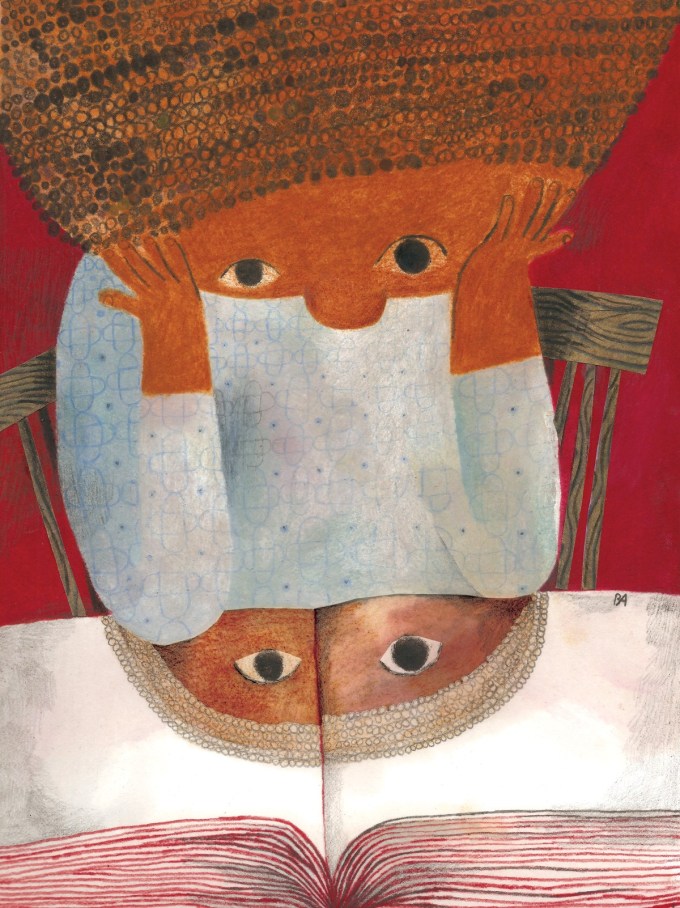And later, when I had left home at sixteen and was living in a Mini, I had my favourite books stashed in the boot and whenever I could be in the library, I was there. This wasn’t a fantasy world or escapism — though it was an escape; it was the hidden door in the blank wall. Open it.
Yet as we travel deeper into the strange world of the story, the feeling we get is of being understood — which is odd when you think about it, because at school learning is based on whether or not we understand what we are reading. In fact it is the story (or the poem) that is understanding us.
When I was growing up poor in a poor place with a pair of Pentecostal parents who were waiting for Jesus to return and roll up time and space like a scroll, I never thought my life was narrow or my chances bleak. I thought I was Heathcliff, Huck Finn, Hotspur, Aladdin, the Big Bad Wolf. The Fish with a Golden Ring.

Reading is an adventure. Adventures are about the unknown. When I started to read seriously I was excited and comforted all at the same time. Literature is a mix of unfamiliarity and recognition. The situation can take us anywhere — across time and space, the globe, through the lives of people who can never be like us — into the heart of anguish we have never felt — crimes we could not commit.
Jeanette Winterson — one of the finest writers and thinkers of our time, a maker of axes and lifelines welded and woven of words — takes up the subject of why we read, a subject on which a reader is tempted to think nothing novel could be said, with uncommon splendor of insight in the introduction to the Audible edition of her 1985 classic Oranges Are Not the Only Fruit (public library).
“A book must be the axe for the frozen sea inside us,” Kafka wrote to his childhood friend just as he was setting out on a life of making and honing axes of words. I have always been struck by his metaphor — by both the exquisite truth of its tenor and the awful violence of its vehicle. A good book is indeed a profound transformation and, yes, there can be a violence to how it awakens us from the trance of near-life, but it is often a transformation of great subtlety and tenderness — an act of healing, a self-salvation, a self-creation. “Books and stories are medicine, plaster casts for broken lives and hearts, slings for weakened spirits,” Anne Lamott wrote in her lovely letter to children a century after Kafka. As a child, Jane Goodall read herself into her unexampled life. As a girl cusping on adulthood, Helen Fagin read herself alive through the Holocaust.
One of the things the story teaches us is this: Read yourself as a fiction as well as a fact.
Complement with Rebecca Solnit on how books empower, solace, and transform us and Alain de Botton on books as portals to self-understanding, then revisit Winterson on how art and storytelling redeem our inner lives, the paradox of active surrender at the heart of all art, and her 10 rules of writing
The escape into another story reminds us that we too are another story. Not caught, not confined, not predestined, not only one gender or passion. Learning to read yourself as a fiction as well as a fact is liberating — it is the difference between energy and mass. Mass is the beloved object — the world we can touch and feel — but mass is also the dead weight in ourselves and others.
The trick is to turn your own life into something that has meaning for people whose experience is nothing like your own. Write what you know is reasonable advice. Read what you don’t know is better advice.

The unknown in life — the unknown in ourselves, the unknowns of the world — is always a double-edged sword of thrill and terror. The unknown in literature, Winterson observes in consonance with the central fact of life — the fact that we are always figuring ourselves forward in an uncertain universe — becomes a safe vessel from which to explore the uncharted territories of our knowledge and our self-knowledge:
In a sentiment particularly resonant to those of us who read ourselves through difficult lives, and out of them, and into improbable new lives, Winterson counsels on how to best read for self-transformation:
We read for countless reasons and books transform us in countless ways, reckoned and unreckoned. We read the way we love — with our whole selves, with the flickering constellation of values, longings, traumas, joys, hopes, despairs, formative experiences, and half-remembered impressions composing the self. We read with our whole being, but we also read ourselves into being as each book quietly reconfigures the constellation with its cosmogony of ideas and the emotional voyage on which it takes us, so that we emerge from it a different self. That, too, is how love transforms us.
Winterson begins where books begin — in the life and mind of the author, a fact so basic we have grown blind to its magic: How is it that a single person’s experience can become raw material for something that speaks to generations of strangers, something that shapes selves radically different from the author’s and from each other’s? She considers what it takes to write from a deeply personal place in a way that bridges the abyssal divide between consciousnesses:
Books read us back to ourselves.
I opened the book and went through.
Shifting the dead weight takes energy but at its atomic core the dead weight is energy. Transforming mass into energy, energy into mass is what creative work is about. An idea becomes embodied. A tragedy is released.







